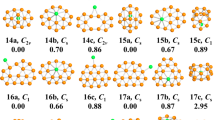Abstract
Titanium diboride was calculated by the density function and discrete variational (DFT-DVM) method to study the relation between structure and properties. Titanium and its first-nearest boron atoms form a strong covalent bond, so TiB2 has high melting point, hardness and chemical stability. Titanium atom releases two electrons to form Ti2+ ions, and a boron atom gets one electron to come into B− ion. B− takes the sp2 hybrid and forms σ bonds to link other boron atoms in the same layer. The other one 2pz orbital of every B− ion in the same layer interacts each other to form the π molecular orbital, so TiB2 has fine electrical property. The calculated density of state is close to the result of XPS experiment of TiB2. Mainly Ti3d and B2p atomic orbitals contribute the total DOS near the Fermi level.
Similar content being viewed by others
References
Sanchez J M, Azcona I, Castro F. Mechanical Properties of Titanium Diboride Based Cermets.Journal of Materials Science, 2000, 35:9–14.
Park J H, Koh Y H, Kim H E, Hwang C S. Densification and Mechanical Properties of Titanium Diboride with Silicon Nitride as a Sintering Aid.Journal of American Ceramic Society, 1999, 82(11):3037–3042.
Barandika M G, Echeberria J J, Sanchez J M, Castro F. Consolidation, Microstructure, and Mechanical Properties of a TiB2−Ni3Al Composites.Materials Research Bulletin, 1999,34(1):53–61.
Ji Jia-ming, Zhou Fei, Li Zhong-hua,et al. Electron Theory Studies on Structure and Properties for TiB2 and ZrB2 Phases.The Chinese Journal of Noferrous Metals, 2000, 10(3):358–360.
Xiao Shen-xiou, Wang Cong-yu and Chen Tian-lang.The Method of Density Function and Discrete Variation Used in Chemistry and Material Physics. Beijing: Science Press. 1998.
Min Xin-min, Hong Han-lie, An Ji-minget al. Structure and Chemical Bond of Thermoelectric Ce−Co−Sb Skutterudites.J. Wuhan Univ. Tech.-Mat. Sci. Ed., 2001, 16(1):10–13.
Min Xin-min, Hong Han-lie, An Ji-ming, Quantum Chemistry Calculation on the Interaction between Kaolinite and Gold.J. Wuhan Univ. Tech.-Mat. Sci. Ed., 2001, 16(14):58–61.
Author information
Authors and Affiliations
Additional information
MIN Xin-min: Born in 1953
Funded by the National Natural Science Foundation of China (No. 59802008)
Rights and permissions
About this article
Cite this article
Xin-min, M., Rui-juan, X., Hao, W. et al. Electronic structure and chemical bond of titanium diboride. J. Wuhan Univ. Technol.-Mat. Sci. Edit. 18, 11–14 (2003). https://doi.org/10.1007/BF02838790
Received:
Accepted:
Issue Date:
DOI: https://doi.org/10.1007/BF02838790




